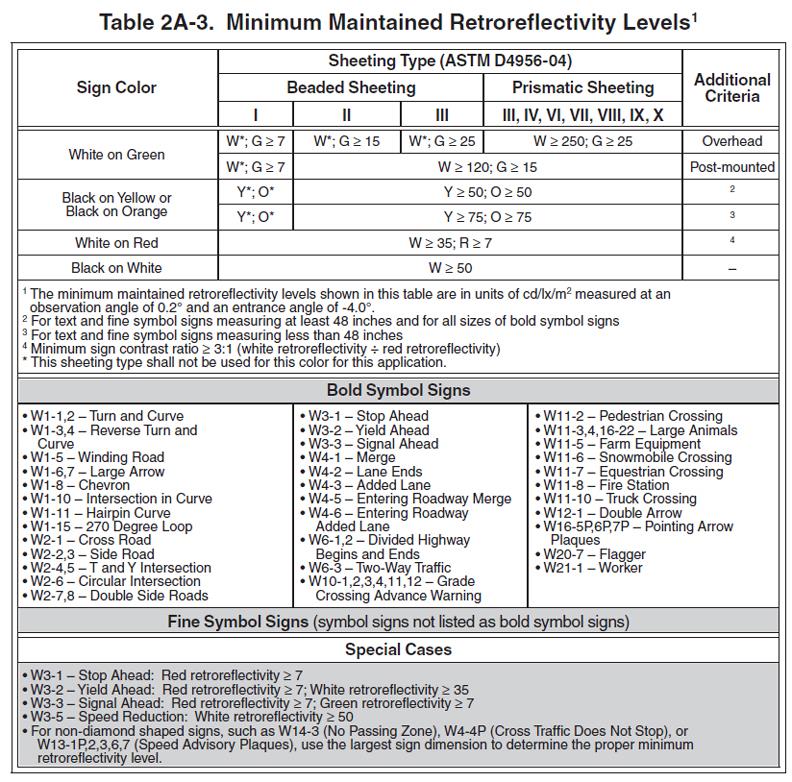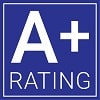MUTCD Visibility of Traffic Signs
Minimum retroreflectivity standards also apply to Private Roads
Effective January 17, 2007, MUTCD regulations apply to "all roads open to public travel."
Includes toll roads and roads within shopping centers, parking lots, airports, sports arenas, and other similar business and recreation facilities that are privately owned but where the public is allowed to travel without access restrictions.
Owners or parties responsible for such private roads have two years from the date of the ruling (January 17, 2007) to bring traffic control devices into compliance with the MUTCD and other applicable State Manuals.
Source:
The FHWA-published table of minimum retroreflectivity values establishes standards of compliance. These values are considered minimums. The agency may decide to use higher values based on their own replacement criteria.
Determines the ratio of retroreflective contrast and sign size ("Conditions").
For example, white-on-red retroreflective signs such as Stop or Do Not Enter signs require a 3:1 (white:red) contrast ratio. When the contrast ratio is lower, the sign should be replaced.
Indicates with an "*" where ASTM I (engineer grade) should not be used such as black on orange/yellow signs. Sheeting material for white-on-red signs should not fall below an RA (coefficient of retroreflection) of 35 measured in candelas per lux per meter squared.
Provides some exclusions for signs such as Parking, Walking, Adopt-A-Highway, Bikeway, etc.)
Effective January 17, 2007, MUTCD regulations apply to "all roads open to public travel."
Includes toll roads and roads within shopping centers, parking lots, airports, sports arenas, and other similar business and recreation facilities that are privately owned but where the public is allowed to travel without access restrictions.
Owners or parties responsible for such private roads have two years from the date of the ruling (January 17, 2007) to bring traffic control devices into compliance with the MUTCD and other applicable State Manuals.
Source:
The FHWA-published table of minimum retroreflectivity values establishes standards of compliance. These values are considered minimums. The agency may decide to use higher values based on their own replacement criteria.
Determines the ratio of retroreflective contrast and sign size ("Conditions").
For example, white-on-red retroreflective signs such as Stop or Do Not Enter signs require a 3:1 (white:red) contrast ratio. When the contrast ratio is lower, the sign should be replaced.
Indicates with an "*" where ASTM I (engineer grade) should not be used such as black on orange/yellow signs. Sheeting material for white-on-red signs should not fall below an RA (coefficient of retroreflection) of 35 measured in candelas per lux per meter squared.
Provides some exclusions for signs such as Parking, Walking, Adopt-A-Highway, Bikeway, etc.)
MUTCD minimums establish a means to improve the nighttime visibility of traffic signs to promote safety, enhance traffic operations and facilitate comfort for drivers of all ages and abilities.
MUTCD standards for sign retroreflectivity or illumination have remained essentially unchanged for 45 years. In the 1980's, the FHWA began night time sign visibility research and in 1993 Congress directed the FHWA to revise the MUTCD to include minimum levels. That ruling has produced minimums for critical traffic signs with a table of specific requirements and implementation (referenced below).
FHWA Standard
One or more of the following assessment or management methods shall be used to maintain sign retroreflectivity above the minimum levels:
Visual nighttime inspections
Measured retroreflectivity
Expected life
Blanket replacement
Control signs
MUTCD standards for sign retroreflectivity or illumination have remained essentially unchanged for 45 years. In the 1980's, the FHWA began night time sign visibility research and in 1993 Congress directed the FHWA to revise the MUTCD to include minimum levels. That ruling has produced minimums for critical traffic signs with a table of specific requirements and implementation (referenced below).
FHWA Standard
One or more of the following assessment or management methods shall be used to maintain sign retroreflectivity above the minimum levels:
Visual nighttime inspections
Measured retroreflectivity
Expected life
Blanket replacement
Control signs
New Retroreflectivity standards were added to the MUTCD in December 2007 and related compliance dates were revised in May 2012.
The standards are a result of many years of research regarding the needs of the drivers – how many have heard about retroreflectivity before?
The intent of the standards are a solution that meets the needs of most involved.
The standards are a result of many years of research regarding the needs of the drivers – how many have heard about retroreflectivity before?
The intent of the standards are a solution that meets the needs of most involved.
Why the big concern over retroreflectivity?
While only 25% of travel is done during the night, night time vehicle fatalities account for 50% of all vehicular fatalities in the US.
The nighttime crash rate is nearly three times that of daytime!
Both behavioral (fatigue, alcohol) and engineering contributors to this disparity between nighttime and daytime -- Improving visibility helps everyone.
The nighttime crash rate is nearly three times that of daytime!
Both behavioral (fatigue, alcohol) and engineering contributors to this disparity between nighttime and daytime -- Improving visibility helps everyone.
Sources:
Crash Data – NHTSA Fatal Accident Reporting System
VMT – FHWA Highway Statistics
Crash Data – NHTSA Fatal Accident Reporting System
VMT – FHWA Highway Statistics
When Should I Replace A Sign?
Signs degrade with sunlight, weather, and other environmental factors. Daylight and nighttime degradation varies.
Section 2A.08 Maintaining Minimum Retroreflectivity

You can also find this information in the Manual on Uniform Traffic Control Devices. https://mutcd.fhwa.dot.gov/
How Can I Maintain Retroreflectivity Standards?
- Nighttime visual inspections.
- Calibration signs
- Comparison panels
- Consistent Parameters
- Measured Sign Retro.
- Expected Sign Life.
- Blanket Sign Replacement.
- Control Signs.
- Future Method Based on Engineering Study.
- Mixture of any of the above.
- Calibration signs
- Comparison panels
- Consistent Parameters
- Measured Sign Retro.
- Expected Sign Life.
- Blanket Sign Replacement.
- Control Signs.
- Future Method Based on Engineering Study.
- Mixture of any of the above.
Signs Exempt from Retroreflectivity Standards
- Parking signs
- Handicap Signs
- Walking / hitchhiking signs
- Adopt-a-Highway signs
- Blue or Brown Background signs
- Pedestrian or Cycling signs
- Handicap Signs
- Walking / hitchhiking signs
- Adopt-a-Highway signs
- Blue or Brown Background signs
- Pedestrian or Cycling signs
Note: these signs must still meet other MUTCD standards and requirements.


Call Now


Call Now
Traffic Signs for Minneapolis, St Paul and greater MN since 1988
Other Services
Products
